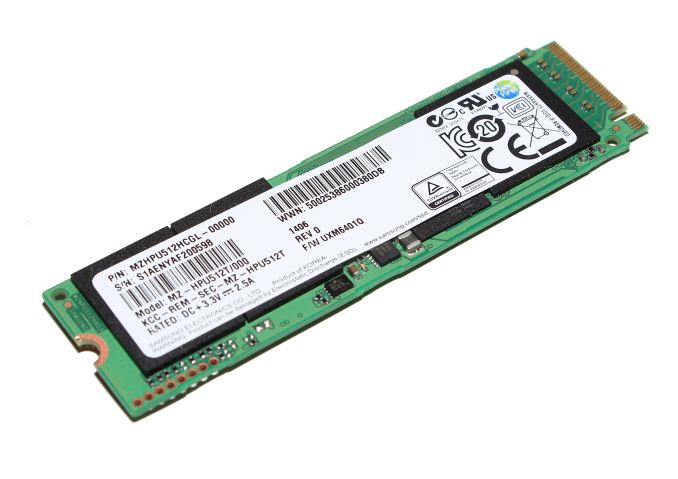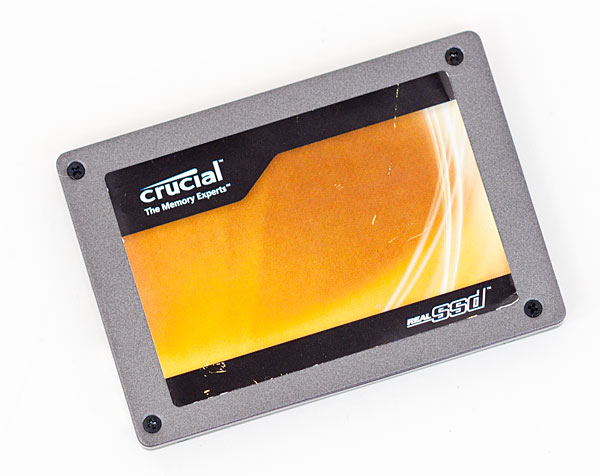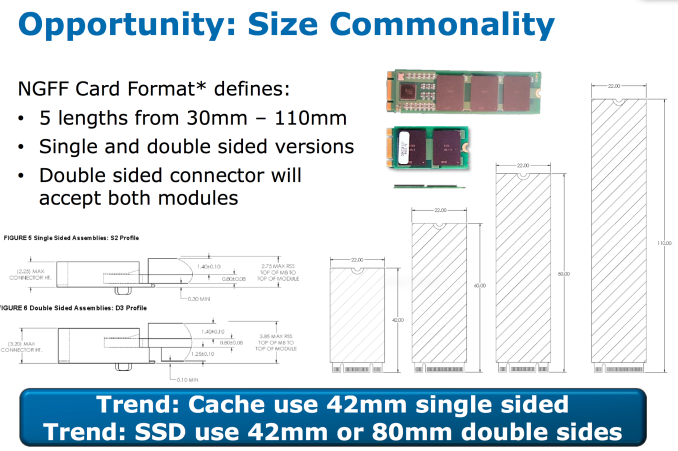Samsung SSD XP941 Review: The PCIe Era Is Here
by Kristian Vättö on May 15, 2014 12:00 PM EST
When SATA was introduced a bit over a decade ago, it provided major advantages over the old PATA interface. Not only was it faster and more power efficient thanks to the better signaling protocol, but the cabling was no longer big and clumsy with very limited length. It was no wonder that the industry quickly adopted SATA as the new interface for client storage and it has held its position throughout the years.
Since hard drives were the dominant storage media, SATA provided everything that the industry needed. The first generation SATA 1.5Gbps was already fast enough for the vast majority of use cases but about two years after the initial release of SATA, the second generation SATA was ready for prime time, doubling the throughput to 3Gbps. Even today's fastest hard drives can't fully saturate SATA 3Gbps, so there was obviously no rush to improve the interface as it already met the industry's needs. But that changed quickly around 2008.
The reason wasn't a sudden improvement in hard drive technology, but an emerging new technology that was based on non-volatile memory. We're talking about SSDs of course. The non-volatile memory part wasn't actually anything new as NAND has been around since the late 80s, but it was the first time NAND was being used in a PC form factor. Previously NAND had mainly been the choice for ultra mobile devices like MP3 players and phones but it was realized that the technology had the potential to be used in all computer-like devices, including PCs and servers. Since NAND was a solid-state semiconductor and it didn't have to rely on mechanical rotation, it allowed for much, much greater speeds. It's simply much faster to move electrons around a silicon chip than it is to rotate a heavy metal disk.
Obviously the first generation SSDs weren't all that fast and in many cases a traditional hard drive would still provide better sequential performance (although SSDs would destroy hard drives in a random IO workload). However, as the SSD companies learned to manage NAND and its characteristics better, the performance went up significantly. In 2009 we were already at a point where SATA 3Gbps was bottlenecking drives and a faster interface was needed to unleash the performance of NAND. Fortunately the Serial ATA International Organization (SATA-IO) had already released the standard for third generation SATA, which would again double the bandwidth to 6Gbps.
Crucial's C300
In 2010 we saw the first SATA 6Gbps SSD, Crucial's C300, make its appearance. Back then SATA 6Gbps wasn't integrated into chipsets yet and users had to buy a SATA 6Gbps PCIe card (or a motherboard with a third party SATA 6Gbps controller) to utilize the drive's full performance, but as soon as Intel was ready with their 6-series chipsets with native SATA 6Gbps support, every man and his dog came out with a SATA 6Gbps SSD.
But there was a problem. SATA 6Gbps still wasn't fast enough to meet the needs of SSD manufacturers as they were already able to saturate it. SATA-IO was given a difficult task: they would have to come up with a new standard with drastically better performance only a few years after the previous strandard had been announced. Not only would it have to be faster, but it also needed to be cost and power efficient. Instead of developing the SATA protocol further, which would have been expensive and time consuming, SATA-IO decided to utilize an existing interface found in every mainstream computer: PCI Express.
To allow backwards compatibility with the SATA interface, SATA-IO came up with two standards: SATA Express and M.2 (formerly NGFF). The idea behind SATA Express is that it routes PCIe and SATA 6Gbps signals to a single connector, which can then be used to connect either PCIe or SATA devices depending on the drive. It's mainly aimed at the desktop crowd and we did an extensive review of it just a while ago. M.2 on the other hand is the successor of mSATA and is electrically very similar to SATA Express. It also supports both PCIe and SATA 6Gbps signals, although ultimately it's up to the PC OEM to choose whether it will route both to the slot (i.e. you can have an M.2 slot with just PCIe or just SATA functionality).












110 Comments
View All Comments
McTeags - Thursday, May 15, 2014 - link
I think there is a spelling mistake in the first sentence. Did you mean SATA instead of PATA? I don't know all of the tech lingo so maybe I'm mistaken.McTeags - Thursday, May 15, 2014 - link
Please disregard my comment. I googled it...BMNify - Thursday, May 15, 2014 - link
sata-e[serial], sata[serial], pata[parrallel] ,SCSI [several, and chainable to 15+ drives on one cable, we should have used that as generic] ,shugart these are all drive interfaces and there are more too going back in the day....metayoshi - Thursday, May 15, 2014 - link
"It's simply much faster to move electrons around a silicon chip than it is to rotate a heavy metal disk."While SSD performance blows HDDs out of the water, the quoted statement is technically not correct. If you take a single channel NAND part and put it up against today's mechanical HDDs, the HDD will probably blow the NAND part out of the water in everything except for random reads.
What really kills HDD performance isn't the just rotational speed as much as it is the track-to-track seek + rotational latency of a random workload. A sequential workload will reduce the seek and rotational latency so much that the areal density of today's 5 TB HDDs will give you pretty good numbers. In a random workload however, the next block of data you want to read is most likely on a different track, different platter, and different head. Now it has to seek the heads to the correct track, perform a head switch because only 1 head can be on at a time, and then wait for the rotation of the disk for that data block to be under the head.
A NAND part with a low number of channels will give you pretty crappy performance. Just look at the NAND in smartphones and tablets of today, and in the SD cards and USB thumb drives of yesteryear. What really makes SSDs shine is that they have multiple NAND parts on these things, and that they stripe the data across a huge number of channels. Just think RAID 0 with HDDs, except this time, it's done by the SSD controller itself, so the motherboard only needs 1 SATA (or other like PCIe) interface to the SSD. That really put SSDs on the map, and if a single NAND chip can do 40 MB/s writes, think about 16 of them doing it at the same time.
So yes, there's no question that the main advantage of SSDs vs HDDs is an electrical vs mechanical thing. It's just simply not true that reading the electrical signals off of a single NAND part is faster than reading the bits off of a sequential track in an HDD. It's a lot of different things working together.
iwod - Friday, May 16, 2014 - link
I skim read it. Few things i notice, No Power usage testing. But 0.05w idle is pretty amazing. Since the PCI-E supply the power as well i guess they could be much better fine grained? Although Active was 5.6W. So at the same time we want more performance == faster controller while using much lower power. it seems there could be more work to do.I wonder if the relative slow Random I/O were due to Samsung betting its use on NVMe instead of ACHI.
iwod - Friday, May 16, 2014 - link
It also prove my points about Random I/O. We see how Random I/O for xp941 being at the bottom of the chart while getting much better benchmarks results. Seq I/O matters! And It matters a lot. The PCI -E x4 interfaces will once again becomes bottleneck until we move to PCI-E 3.0 Which i hope we do in 2015.Although i have this suspicious feeling intel is delaying or slowing down our progression.
nevertell - Friday, May 16, 2014 - link
Can't you place the bootloader on a hard drive, yet have it load the OS up from the SSD ?rxzlmn - Friday, May 16, 2014 - link
'Boot Support: Mac? Yes. PC? Mostly No.'Uh, a Mac is a PC. On a serious tech site I don't expect lines like that.
Penti - Friday, May 16, 2014 - link
Firmware differences.Haravikk - Friday, May 16, 2014 - link
It still surprises me that PCs can have so many hurdles when it comes to booting from various devices; for years now Macs have been able to boot from just about anything you plug into them (that can store data of course). I have one machine already that uses an internal drive combined with an external USB drive as a Fusion Drive, and it not only boots just fine, but the Fusion setup really helps eliminate the USB performance issues.Anyway, it's good to see PCIe storage properly reaching general release; it's probably going to be a while before I adopt it on PCs, as I'm still finding regular SATA or M.2 flash storage runs just fine for my needs, but having tried Apple's new Mac Pros, the PCIe flash really is awesome. Hopefully the next generation of Mac Pros will have connectors for two, as combined in a RAID-0 or RAID-1 the read performance can be absolutely staggering.